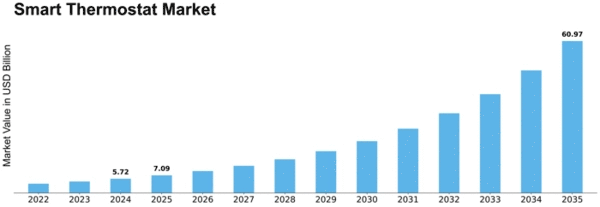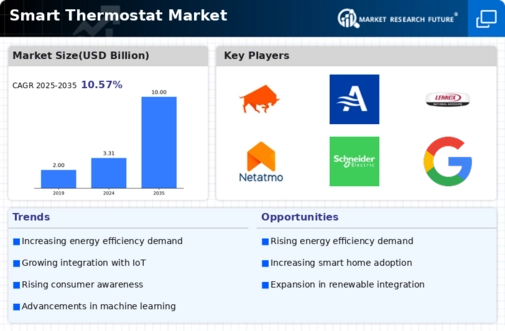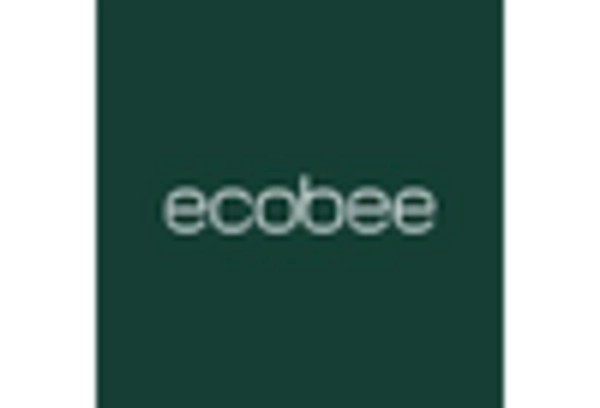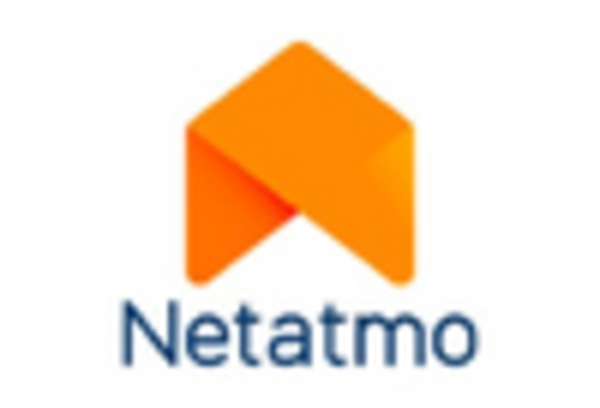-
EXECUTIVE SUMMARY
-
Market Overview
-
Key Findings
-
Market Segmentation
-
Competitive Landscape
-
Challenges and Opportunities
-
Future Outlook
-
MARKET INTRODUCTION
-
Definition
-
Scope of the study
- Research Objective
- Assumption
- Limitations
-
RESEARCH METHODOLOGY
-
Overview
-
Data Mining
-
Secondary Research
-
Primary Research
- Primary Interviews and Information Gathering Process
- Breakdown of Primary Respondents
-
Forecasting Model
-
Market Size Estimation
- Bottom-Up Approach
- Top-Down Approach
-
Data Triangulation
-
Validation
-
MARKET DYNAMICS
-
Overview
-
Drivers
-
Restraints
-
Opportunities
-
MARKET FACTOR ANALYSIS
-
Value chain Analysis
-
Porter's Five Forces Analysis
- Bargaining Power of Suppliers
- Bargaining Power of Buyers
- Threat of New Entrants
- Threat of Substitutes
- Intensity of Rivalry
-
COVID-19 Impact Analysis
- Market Impact Analysis
- Regional Impact
- Opportunity and Threat Analysis
-
SMART THERMOSTAT MARKET, BY TECHNOLOGY (USD BILLION)
-
Wi-Fi Enabled Thermostats
-
Zigbee Enabled Thermostats
-
Bluetooth Enabled Thermostats
-
Thread Enabled Thermostats
-
SMART THERMOSTAT MARKET, BY COMPATIBILITY (USD BILLION)
-
HVAC Systems
-
Heat Pumps
-
Boilers
-
Radiant Heating Systems
-
SMART THERMOSTAT MARKET, BY APPLICATION (USD BILLION)
-
Residential
-
Commercial
-
Industrial
-
SMART THERMOSTAT MARKET, BY FUNCTIONALITY (USD BILLION)
-
Learning Thermostats
-
Programmable Thermostats
-
Smart Phone Controlled Thermostats
-
SMART THERMOSTAT MARKET, BY REGIONAL (USD BILLION)
-
North America
- US
- Canada
-
Europe
- Germany
- UK
- France
- Russia
- Italy
- Spain
- Rest of Europe
-
APAC
- China
- India
- Japan
- South Korea
- Malaysia
- Thailand
- Indonesia
- Rest of APAC
-
South America
- Brazil
- Mexico
- Argentina
- Rest of South America
-
MEA
- GCC Countries
- South Africa
- Rest of MEA
-
COMPETITIVE LANDSCAPE
-
Overview
-
Competitive Analysis
-
Market share Analysis
-
Major Growth Strategy in the Smart Thermostat Market
-
Competitive Benchmarking
-
Leading Players in Terms of Number of Developments in the Smart Thermostat Market
-
Key developments and growth strategies
- New Product Launch/Service Deployment
- Merger & Acquisitions
- Joint Ventures
-
Major Players Financial Matrix
- Sales and Operating Income
- Major Players R&D Expenditure. 2023
-
COMPANY PROFILES
-
Sensi
- Financial Overview
- Products Offered
- Key Developments
- SWOT Analysis
- Key Strategies
-
Aprilaire
- Financial Overview
- Products Offered
- Key Developments
- SWOT Analysis
- Key Strategies
-
Lennox International
- Financial Overview
- Products Offered
- Key Developments
- SWOT Analysis
- Key Strategies
-
Netatmo
- Financial Overview
- Products Offered
- Key Developments
- SWOT Analysis
- Key Strategies
-
Schneider Electric
- Financial Overview
- Products Offered
- Key Developments
- SWOT Analysis
- Key Strategies
-
Google
- Financial Overview
- Products Offered
- Key Developments
- SWOT Analysis
- Key Strategies
-
Honeywell
- Financial Overview
- Products Offered
- Key Developments
- SWOT Analysis
- Key Strategies
-
Ecobee
- Financial Overview
- Products Offered
- Key Developments
- SWOT Analysis
- Key Strategies
-
Emerson
- Financial Overview
- Products Offered
- Key Developments
- SWOT Analysis
- Key Strategies
-
Johnson Controls
- Financial Overview
- Products Offered
- Key Developments
- SWOT Analysis
- Key Strategies
-
Savant
- Financial Overview
- Products Offered
- Key Developments
- SWOT Analysis
- Key Strategies
-
Nest Labs
- Financial Overview
- Products Offered
- Key Developments
- SWOT Analysis
- Key Strategies
-
Bosch
- Financial Overview
- Products Offered
- Key Developments
- SWOT Analysis
- Key Strategies
-
Tado
- Financial Overview
- Products Offered
- Key Developments
- SWOT Analysis
- Key Strategies
-
Hive
- Financial Overview
- Products Offered
- Key Developments
- SWOT Analysis
- Key Strategies
-
APPENDIX
-
References
-
Related Reports
-
LIST OF TABLES
-
LIST OF ASSUMPTIONS
-
NORTH AMERICA SMART THERMOSTAT MARKET SIZE ESTIMATES & FORECAST, BY TECHNOLOGY, 2019-2035 (USD BILLIONS)
-
NORTH AMERICA SMART THERMOSTAT MARKET SIZE ESTIMATES & FORECAST, BY COMPATIBILITY, 2019-2035 (USD BILLIONS)
-
NORTH AMERICA SMART THERMOSTAT MARKET SIZE ESTIMATES & FORECAST, BY APPLICATION, 2019-2035 (USD BILLIONS)
-
NORTH AMERICA SMART THERMOSTAT MARKET SIZE ESTIMATES & FORECAST, BY FUNCTIONALITY, 2019-2035 (USD BILLIONS)
-
NORTH AMERICA SMART THERMOSTAT MARKET SIZE ESTIMATES & FORECAST, BY REGIONAL, 2019-2035 (USD BILLIONS)
-
US SMART THERMOSTAT MARKET SIZE ESTIMATES & FORECAST, BY TECHNOLOGY, 2019-2035 (USD BILLIONS)
-
US SMART THERMOSTAT MARKET SIZE ESTIMATES & FORECAST, BY COMPATIBILITY, 2019-2035 (USD BILLIONS)
-
US SMART THERMOSTAT MARKET SIZE ESTIMATES & FORECAST, BY APPLICATION, 2019-2035 (USD BILLIONS)
-
US SMART THERMOSTAT MARKET SIZE ESTIMATES & FORECAST, BY FUNCTIONALITY, 2019-2035 (USD BILLIONS)
-
US SMART THERMOSTAT MARKET SIZE ESTIMATES & FORECAST, BY REGIONAL, 2019-2035 (USD BILLIONS)
-
CANADA SMART THERMOSTAT MARKET SIZE ESTIMATES & FORECAST, BY TECHNOLOGY, 2019-2035 (USD BILLIONS)
-
CANADA SMART THERMOSTAT MARKET SIZE ESTIMATES & FORECAST, BY COMPATIBILITY, 2019-2035 (USD BILLIONS)
-
CANADA SMART THERMOSTAT MARKET SIZE ESTIMATES & FORECAST, BY APPLICATION, 2019-2035 (USD BILLIONS)
-
CANADA SMART THERMOSTAT MARKET SIZE ESTIMATES & FORECAST, BY FUNCTIONALITY, 2019-2035 (USD BILLIONS)
-
CANADA SMART THERMOSTAT MARKET SIZE ESTIMATES & FORECAST, BY REGIONAL, 2019-2035 (USD BILLIONS)
-
EUROPE SMART THERMOSTAT MARKET SIZE ESTIMATES & FORECAST, BY TECHNOLOGY, 2019-2035 (USD BILLIONS)
-
EUROPE SMART THERMOSTAT MARKET SIZE ESTIMATES & FORECAST, BY COMPATIBILITY, 2019-2035 (USD BILLIONS)
-
EUROPE SMART THERMOSTAT MARKET SIZE ESTIMATES & FORECAST, BY APPLICATION, 2019-2035 (USD BILLIONS)
-
EUROPE SMART THERMOSTAT MARKET SIZE ESTIMATES & FORECAST, BY FUNCTIONALITY, 2019-2035 (USD BILLIONS)
-
EUROPE SMART THERMOSTAT MARKET SIZE ESTIMATES & FORECAST, BY REGIONAL, 2019-2035 (USD BILLIONS)
-
GERMANY SMART THERMOSTAT MARKET SIZE ESTIMATES & FORECAST, BY TECHNOLOGY, 2019-2035 (USD BILLIONS)
-
GERMANY SMART THERMOSTAT MARKET SIZE ESTIMATES & FORECAST, BY COMPATIBILITY, 2019-2035 (USD BILLIONS)
-
GERMANY SMART THERMOSTAT MARKET SIZE ESTIMATES & FORECAST, BY APPLICATION, 2019-2035 (USD BILLIONS)
-
GERMANY SMART THERMOSTAT MARKET SIZE ESTIMATES & FORECAST, BY FUNCTIONALITY, 2019-2035 (USD BILLIONS)
-
GERMANY SMART THERMOSTAT MARKET SIZE ESTIMATES & FORECAST, BY REGIONAL, 2019-2035 (USD BILLIONS)
-
UK SMART THERMOSTAT MARKET SIZE ESTIMATES & FORECAST, BY TECHNOLOGY, 2019-2035 (USD BILLIONS)
-
UK SMART THERMOSTAT MARKET SIZE ESTIMATES & FORECAST, BY COMPATIBILITY, 2019-2035 (USD BILLIONS)
-
UK SMART THERMOSTAT MARKET SIZE ESTIMATES & FORECAST, BY APPLICATION, 2019-2035 (USD BILLIONS)
-
UK SMART THERMOSTAT MARKET SIZE ESTIMATES & FORECAST, BY FUNCTIONALITY, 2019-2035 (USD BILLIONS)
-
UK SMART THERMOSTAT MARKET SIZE ESTIMATES & FORECAST, BY REGIONAL, 2019-2035 (USD BILLIONS)
-
FRANCE SMART THERMOSTAT MARKET SIZE ESTIMATES & FORECAST, BY TECHNOLOGY, 2019-2035 (USD BILLIONS)
-
FRANCE SMART THERMOSTAT MARKET SIZE ESTIMATES & FORECAST, BY COMPATIBILITY, 2019-2035 (USD BILLIONS)
-
FRANCE SMART THERMOSTAT MARKET SIZE ESTIMATES & FORECAST, BY APPLICATION, 2019-2035 (USD BILLIONS)
-
FRANCE SMART THERMOSTAT MARKET SIZE ESTIMATES & FORECAST, BY FUNCTIONALITY, 2019-2035 (USD BILLIONS)
-
FRANCE SMART THERMOSTAT MARKET SIZE ESTIMATES & FORECAST, BY REGIONAL, 2019-2035 (USD BILLIONS)
-
RUSSIA SMART THERMOSTAT MARKET SIZE ESTIMATES & FORECAST, BY TECHNOLOGY, 2019-2035 (USD BILLIONS)
-
RUSSIA SMART THERMOSTAT MARKET SIZE ESTIMATES & FORECAST, BY COMPATIBILITY, 2019-2035 (USD BILLIONS)
-
RUSSIA SMART THERMOSTAT MARKET SIZE ESTIMATES & FORECAST, BY APPLICATION, 2019-2035 (USD BILLIONS)
-
RUSSIA SMART THERMOSTAT MARKET SIZE ESTIMATES & FORECAST, BY FUNCTIONALITY, 2019-2035 (USD BILLIONS)
-
RUSSIA SMART THERMOSTAT MARKET SIZE ESTIMATES & FORECAST, BY REGIONAL, 2019-2035 (USD BILLIONS)
-
ITALY SMART THERMOSTAT MARKET SIZE ESTIMATES & FORECAST, BY TECHNOLOGY, 2019-2035 (USD BILLIONS)
-
ITALY SMART THERMOSTAT MARKET SIZE ESTIMATES & FORECAST, BY COMPATIBILITY, 2019-2035 (USD BILLIONS)
-
ITALY SMART THERMOSTAT MARKET SIZE ESTIMATES & FORECAST, BY APPLICATION, 2019-2035 (USD BILLIONS)
-
ITALY SMART THERMOSTAT MARKET SIZE ESTIMATES & FORECAST, BY FUNCTIONALITY, 2019-2035 (USD BILLIONS)
-
ITALY SMART THERMOSTAT MARKET SIZE ESTIMATES & FORECAST, BY REGIONAL, 2019-2035 (USD BILLIONS)
-
SPAIN SMART THERMOSTAT MARKET SIZE ESTIMATES & FORECAST, BY TECHNOLOGY, 2019-2035 (USD BILLIONS)
-
SPAIN SMART THERMOSTAT MARKET SIZE ESTIMATES & FORECAST, BY COMPATIBILITY, 2019-2035 (USD BILLIONS)
-
SPAIN SMART THERMOSTAT MARKET SIZE ESTIMATES & FORECAST, BY APPLICATION, 2019-2035 (USD BILLIONS)
-
SPAIN SMART THERMOSTAT MARKET SIZE ESTIMATES & FORECAST, BY FUNCTIONALITY, 2019-2035 (USD BILLIONS)
-
SPAIN SMART THERMOSTAT MARKET SIZE ESTIMATES & FORECAST, BY REGIONAL, 2019-2035 (USD BILLIONS)
-
REST OF EUROPE SMART THERMOSTAT MARKET SIZE ESTIMATES & FORECAST, BY TECHNOLOGY, 2019-2035 (USD BILLIONS)
-
REST OF EUROPE SMART THERMOSTAT MARKET SIZE ESTIMATES & FORECAST, BY COMPATIBILITY, 2019-2035 (USD BILLIONS)
-
REST OF EUROPE SMART THERMOSTAT MARKET SIZE ESTIMATES & FORECAST, BY APPLICATION, 2019-2035 (USD BILLIONS)
-
REST OF EUROPE SMART THERMOSTAT MARKET SIZE ESTIMATES & FORECAST, BY FUNCTIONALITY, 2019-2035 (USD BILLIONS)
-
REST OF EUROPE SMART THERMOSTAT MARKET SIZE ESTIMATES & FORECAST, BY REGIONAL, 2019-2035 (USD BILLIONS)
-
APAC SMART THERMOSTAT MARKET SIZE ESTIMATES & FORECAST, BY TECHNOLOGY, 2019-2035 (USD BILLIONS)
-
APAC SMART THERMOSTAT MARKET SIZE ESTIMATES & FORECAST, BY COMPATIBILITY, 2019-2035 (USD BILLIONS)
-
APAC SMART THERMOSTAT MARKET SIZE ESTIMATES & FORECAST, BY APPLICATION, 2019-2035 (USD BILLIONS)
-
APAC SMART THERMOSTAT MARKET SIZE ESTIMATES & FORECAST, BY FUNCTIONALITY, 2019-2035 (USD BILLIONS)
-
APAC SMART THERMOSTAT MARKET SIZE ESTIMATES & FORECAST, BY REGIONAL, 2019-2035 (USD BILLIONS)
-
CHINA SMART THERMOSTAT MARKET SIZE ESTIMATES & FORECAST, BY TECHNOLOGY, 2019-2035 (USD BILLIONS)
-
CHINA SMART THERMOSTAT MARKET SIZE ESTIMATES & FORECAST, BY COMPATIBILITY, 2019-2035 (USD BILLIONS)
-
CHINA SMART THERMOSTAT MARKET SIZE ESTIMATES & FORECAST, BY APPLICATION, 2019-2035 (USD BILLIONS)
-
CHINA SMART THERMOSTAT MARKET SIZE ESTIMATES & FORECAST, BY FUNCTIONALITY, 2019-2035 (USD BILLIONS)
-
CHINA SMART THERMOSTAT MARKET SIZE ESTIMATES & FORECAST, BY REGIONAL, 2019-2035 (USD BILLIONS)
-
INDIA SMART THERMOSTAT MARKET SIZE ESTIMATES & FORECAST, BY TECHNOLOGY, 2019-2035 (USD BILLIONS)
-
INDIA SMART THERMOSTAT MARKET SIZE ESTIMATES & FORECAST, BY COMPATIBILITY, 2019-2035 (USD BILLIONS)
-
INDIA SMART THERMOSTAT MARKET SIZE ESTIMATES & FORECAST, BY APPLICATION, 2019-2035 (USD BILLIONS)
-
INDIA SMART THERMOSTAT MARKET SIZE ESTIMATES & FORECAST, BY FUNCTIONALITY, 2019-2035 (USD BILLIONS)
-
INDIA SMART THERMOSTAT MARKET SIZE ESTIMATES & FORECAST, BY REGIONAL, 2019-2035 (USD BILLIONS)
-
JAPAN SMART THERMOSTAT MARKET SIZE ESTIMATES & FORECAST, BY TECHNOLOGY, 2019-2035 (USD BILLIONS)
-
JAPAN SMART THERMOSTAT MARKET SIZE ESTIMATES & FORECAST, BY COMPATIBILITY, 2019-2035 (USD BILLIONS)
-
JAPAN SMART THERMOSTAT MARKET SIZE ESTIMATES & FORECAST, BY APPLICATION, 2019-2035 (USD BILLIONS)
-
JAPAN SMART THERMOSTAT MARKET SIZE ESTIMATES & FORECAST, BY FUNCTIONALITY, 2019-2035 (USD BILLIONS)
-
JAPAN SMART THERMOSTAT MARKET SIZE ESTIMATES & FORECAST, BY REGIONAL, 2019-2035 (USD BILLIONS)
-
SOUTH KOREA SMART THERMOSTAT MARKET SIZE ESTIMATES & FORECAST, BY TECHNOLOGY, 2019-2035 (USD BILLIONS)
-
SOUTH KOREA SMART THERMOSTAT MARKET SIZE ESTIMATES & FORECAST, BY COMPATIBILITY, 2019-2035 (USD BILLIONS)
-
SOUTH KOREA SMART THERMOSTAT MARKET SIZE ESTIMATES & FORECAST, BY APPLICATION, 2019-2035 (USD BILLIONS)
-
SOUTH KOREA SMART THERMOSTAT MARKET SIZE ESTIMATES & FORECAST, BY FUNCTIONALITY, 2019-2035 (USD BILLIONS)
-
SOUTH KOREA SMART THERMOSTAT MARKET SIZE ESTIMATES & FORECAST, BY REGIONAL, 2019-2035 (USD BILLIONS)
-
MALAYSIA SMART THERMOSTAT MARKET SIZE ESTIMATES & FORECAST, BY TECHNOLOGY, 2019-2035 (USD BILLIONS)
-
MALAYSIA SMART THERMOSTAT MARKET SIZE ESTIMATES & FORECAST, BY COMPATIBILITY, 2019-2035 (USD BILLIONS)
-
MALAYSIA SMART THERMOSTAT MARKET SIZE ESTIMATES & FORECAST, BY APPLICATION, 2019-2035 (USD BILLIONS)
-
MALAYSIA SMART THERMOSTAT MARKET SIZE ESTIMATES & FORECAST, BY FUNCTIONALITY, 2019-2035 (USD BILLIONS)
-
MALAYSIA SMART THERMOSTAT MARKET SIZE ESTIMATES & FORECAST, BY REGIONAL, 2019-2035 (USD BILLIONS)
-
THAILAND SMART THERMOSTAT MARKET SIZE ESTIMATES & FORECAST, BY TECHNOLOGY, 2019-2035 (USD BILLIONS)
-
THAILAND SMART THERMOSTAT MARKET SIZE ESTIMATES & FORECAST, BY COMPATIBILITY, 2019-2035 (USD BILLIONS)
-
THAILAND SMART THERMOSTAT MARKET SIZE ESTIMATES & FORECAST, BY APPLICATION, 2019-2035 (USD BILLIONS)
-
THAILAND SMART THERMOSTAT MARKET SIZE ESTIMATES & FORECAST, BY FUNCTIONALITY, 2019-2035 (USD BILLIONS)
-
THAILAND SMART THERMOSTAT MARKET SIZE ESTIMATES & FORECAST, BY REGIONAL, 2019-2035 (USD BILLIONS)
-
INDONESIA SMART THERMOSTAT MARKET SIZE ESTIMATES & FORECAST, BY TECHNOLOGY, 2019-2035 (USD BILLIONS)
-
INDONESIA SMART THERMOSTAT MARKET SIZE ESTIMATES & FORECAST, BY COMPATIBILITY, 2019-2035 (USD BILLIONS)
-
INDONESIA SMART THERMOSTAT MARKET SIZE ESTIMATES & FORECAST, BY APPLICATION, 2019-2035 (USD BILLIONS)
-
INDONESIA SMART THERMOSTAT MARKET SIZE ESTIMATES & FORECAST, BY FUNCTIONALITY, 2019-2035 (USD BILLIONS)
-
INDONESIA SMART THERMOSTAT MARKET SIZE ESTIMATES & FORECAST, BY REGIONAL, 2019-2035 (USD BILLIONS)
-
REST OF APAC SMART THERMOSTAT MARKET SIZE ESTIMATES & FORECAST, BY TECHNOLOGY, 2019-2035 (USD BILLIONS)
-
REST OF APAC SMART THERMOSTAT MARKET SIZE ESTIMATES & FORECAST, BY COMPATIBILITY, 2019-2035 (USD BILLIONS)
-
REST OF APAC SMART THERMOSTAT MARKET SIZE ESTIMATES & FORECAST, BY APPLICATION, 2019-2035 (USD BILLIONS)
-
REST OF APAC SMART THERMOSTAT MARKET SIZE ESTIMATES & FORECAST, BY FUNCTIONALITY, 2019-2035 (USD BILLIONS)
-
REST OF APAC SMART THERMOSTAT MARKET SIZE ESTIMATES & FORECAST, BY REGIONAL, 2019-2035 (USD BILLIONS)
-
SOUTH AMERICA SMART THERMOSTAT MARKET SIZE ESTIMATES & FORECAST, BY TECHNOLOGY, 2019-2035 (USD BILLIONS)
-
SOUTH AMERICA SMART THERMOSTAT MARKET SIZE ESTIMATES & FORECAST, BY COMPATIBILITY, 2019-2035 (USD BILLIONS)
-
SOUTH AMERICA SMART THERMOSTAT MARKET SIZE ESTIMATES & FORECAST, BY APPLICATION, 2019-2035 (USD BILLIONS)
-
SOUTH AMERICA SMART THERMOSTAT MARKET SIZE ESTIMATES & FORECAST, BY FUNCTIONALITY, 2019-2035 (USD BILLIONS)
-
SOUTH AMERICA SMART THERMOSTAT MARKET SIZE ESTIMATES & FORECAST, BY REGIONAL, 2019-2035 (USD BILLIONS)
-
BRAZIL SMART THERMOSTAT MARKET SIZE ESTIMATES & FORECAST, BY TECHNOLOGY, 2019-2035 (USD BILLIONS)
-
BRAZIL SMART THERMOSTAT MARKET SIZE ESTIMATES & FORECAST, BY COMPATIBILITY, 2019-2035 (USD BILLIONS)
-
BRAZIL SMART THERMOSTAT MARKET SIZE ESTIMATES & FORECAST, BY APPLICATION, 2019-2035 (USD BILLIONS)
-
BRAZIL SMART THERMOSTAT MARKET SIZE ESTIMATES & FORECAST, BY FUNCTIONALITY, 2019-2035 (USD BILLIONS)
-
BRAZIL SMART THERMOSTAT MARKET SIZE ESTIMATES & FORECAST, BY REGIONAL, 2019-2035 (USD BILLIONS)
-
MEXICO SMART THERMOSTAT MARKET SIZE ESTIMATES & FORECAST, BY TECHNOLOGY, 2019-2035 (USD BILLIONS)
-
MEXICO SMART THERMOSTAT MARKET SIZE ESTIMATES & FORECAST, BY COMPATIBILITY, 2019-2035 (USD BILLIONS)
-
MEXICO SMART THERMOSTAT MARKET SIZE ESTIMATES & FORECAST, BY APPLICATION, 2019-2035 (USD BILLIONS)
-
MEXICO SMART THERMOSTAT MARKET SIZE ESTIMATES & FORECAST, BY FUNCTIONALITY, 2019-2035 (USD BILLIONS)
-
MEXICO SMART THERMOSTAT MARKET SIZE ESTIMATES & FORECAST, BY REGIONAL, 2019-2035 (USD BILLIONS)
-
ARGENTINA SMART THERMOSTAT MARKET SIZE ESTIMATES & FORECAST, BY TECHNOLOGY, 2019-2035 (USD BILLIONS)
-
ARGENTINA SMART THERMOSTAT MARKET SIZE ESTIMATES & FORECAST, BY COMPATIBILITY, 2019-2035 (USD BILLIONS)
-
ARGENTINA SMART THERMOSTAT MARKET SIZE ESTIMATES & FORECAST, BY APPLICATION, 2019-2035 (USD BILLIONS)
-
ARGENTINA SMART THERMOSTAT MARKET SIZE ESTIMATES & FORECAST, BY FUNCTIONALITY, 2019-2035 (USD BILLIONS)
-
ARGENTINA SMART THERMOSTAT MARKET SIZE ESTIMATES & FORECAST, BY REGIONAL, 2019-2035 (USD BILLIONS)
-
REST OF SOUTH AMERICA SMART THERMOSTAT MARKET SIZE ESTIMATES & FORECAST, BY TECHNOLOGY, 2019-2035 (USD BILLIONS)
-
REST OF SOUTH AMERICA SMART THERMOSTAT MARKET SIZE ESTIMATES & FORECAST, BY COMPATIBILITY, 2019-2035 (USD BILLIONS)
-
REST OF SOUTH AMERICA SMART THERMOSTAT MARKET SIZE ESTIMATES & FORECAST, BY APPLICATION, 2019-2035 (USD BILLIONS)
-
REST OF SOUTH AMERICA SMART THERMOSTAT MARKET SIZE ESTIMATES & FORECAST, BY FUNCTIONALITY, 2019-2035 (USD BILLIONS)
-
REST OF SOUTH AMERICA SMART THERMOSTAT MARKET SIZE ESTIMATES & FORECAST, BY REGIONAL, 2019-2035 (USD BILLIONS)
-
MEA SMART THERMOSTAT MARKET SIZE ESTIMATES & FORECAST, BY TECHNOLOGY, 2019-2035 (USD BILLIONS)
-
MEA SMART THERMOSTAT MARKET SIZE ESTIMATES & FORECAST, BY COMPATIBILITY, 2019-2035 (USD BILLIONS)
-
MEA SMART THERMOSTAT MARKET SIZE ESTIMATES & FORECAST, BY APPLICATION, 2019-2035 (USD BILLIONS)
-
MEA SMART THERMOSTAT MARKET SIZE ESTIMATES & FORECAST, BY FUNCTIONALITY, 2019-2035 (USD BILLIONS)
-
MEA SMART THERMOSTAT MARKET SIZE ESTIMATES & FORECAST, BY REGIONAL, 2019-2035 (USD BILLIONS)
-
GCC COUNTRIES SMART THERMOSTAT MARKET SIZE ESTIMATES & FORECAST, BY TECHNOLOGY, 2019-2035 (USD BILLIONS)
-
GCC COUNTRIES SMART THERMOSTAT MARKET SIZE ESTIMATES & FORECAST, BY COMPATIBILITY, 2019-2035 (USD BILLIONS)
-
GCC COUNTRIES SMART THERMOSTAT MARKET SIZE ESTIMATES & FORECAST, BY APPLICATION, 2019-2035 (USD BILLIONS)
-
GCC COUNTRIES SMART THERMOSTAT MARKET SIZE ESTIMATES & FORECAST, BY FUNCTIONALITY, 2019-2035 (USD BILLIONS)
-
GCC COUNTRIES SMART THERMOSTAT MARKET SIZE ESTIMATES & FORECAST, BY REGIONAL, 2019-2035 (USD BILLIONS)
-
SOUTH AFRICA SMART THERMOSTAT MARKET SIZE ESTIMATES & FORECAST, BY TECHNOLOGY, 2019-2035 (USD BILLIONS)
-
SOUTH AFRICA SMART THERMOSTAT MARKET SIZE ESTIMATES & FORECAST, BY COMPATIBILITY, 2019-2035 (USD BILLIONS)
-
SOUTH AFRICA SMART THERMOSTAT MARKET SIZE ESTIMATES & FORECAST, BY APPLICATION, 2019-2035 (USD BILLIONS)
-
SOUTH AFRICA SMART THERMOSTAT MARKET SIZE ESTIMATES & FORECAST, BY FUNCTIONALITY, 2019-2035 (USD BILLIONS)
-
SOUTH AFRICA SMART THERMOSTAT MARKET SIZE ESTIMATES & FORECAST, BY REGIONAL, 2019-2035 (USD BILLIONS)
-
REST OF MEA SMART THERMOSTAT MARKET SIZE ESTIMATES & FORECAST, BY TECHNOLOGY, 2019-2035 (USD BILLIONS)
-
REST OF MEA SMART THERMOSTAT MARKET SIZE ESTIMATES & FORECAST, BY COMPATIBILITY, 2019-2035 (USD BILLIONS)
-
REST OF MEA SMART THERMOSTAT MARKET SIZE ESTIMATES & FORECAST, BY APPLICATION, 2019-2035 (USD BILLIONS)
-
REST OF MEA SMART THERMOSTAT MARKET SIZE ESTIMATES & FORECAST, BY FUNCTIONALITY, 2019-2035 (USD BILLIONS)
-
REST OF MEA SMART THERMOSTAT MARKET SIZE ESTIMATES & FORECAST, BY REGIONAL, 2019-2035 (USD BILLIONS)
-
PRODUCT LAUNCH/PRODUCT DEVELOPMENT/APPROVAL
-
ACQUISITION/PARTNERSHIP
-
LIST OF FIGURES
-
MARKET SYNOPSIS
-
NORTH AMERICA SMART THERMOSTAT MARKET ANALYSIS
-
US SMART THERMOSTAT MARKET ANALYSIS BY TECHNOLOGY
-
US SMART THERMOSTAT MARKET ANALYSIS BY COMPATIBILITY
-
US SMART THERMOSTAT MARKET ANALYSIS BY APPLICATION
-
US SMART THERMOSTAT MARKET ANALYSIS BY FUNCTIONALITY
-
US SMART THERMOSTAT MARKET ANALYSIS BY REGIONAL
-
CANADA SMART THERMOSTAT MARKET ANALYSIS BY TECHNOLOGY
-
CANADA SMART THERMOSTAT MARKET ANALYSIS BY COMPATIBILITY
-
CANADA SMART THERMOSTAT MARKET ANALYSIS BY APPLICATION
-
CANADA SMART THERMOSTAT MARKET ANALYSIS BY FUNCTIONALITY
-
CANADA SMART THERMOSTAT MARKET ANALYSIS BY REGIONAL
-
EUROPE SMART THERMOSTAT MARKET ANALYSIS
-
GERMANY SMART THERMOSTAT MARKET ANALYSIS BY TECHNOLOGY
-
GERMANY SMART THERMOSTAT MARKET ANALYSIS BY COMPATIBILITY
-
GERMANY SMART THERMOSTAT MARKET ANALYSIS BY APPLICATION
-
GERMANY SMART THERMOSTAT MARKET ANALYSIS BY FUNCTIONALITY
-
GERMANY SMART THERMOSTAT MARKET ANALYSIS BY REGIONAL
-
UK SMART THERMOSTAT MARKET ANALYSIS BY TECHNOLOGY
-
UK SMART THERMOSTAT MARKET ANALYSIS BY COMPATIBILITY
-
UK SMART THERMOSTAT MARKET ANALYSIS BY APPLICATION
-
UK SMART THERMOSTAT MARKET ANALYSIS BY FUNCTIONALITY
-
UK SMART THERMOSTAT MARKET ANALYSIS BY REGIONAL
-
FRANCE SMART THERMOSTAT MARKET ANALYSIS BY TECHNOLOGY
-
FRANCE SMART THERMOSTAT MARKET ANALYSIS BY COMPATIBILITY
-
FRANCE SMART THERMOSTAT MARKET ANALYSIS BY APPLICATION
-
FRANCE SMART THERMOSTAT MARKET ANALYSIS BY FUNCTIONALITY
-
FRANCE SMART THERMOSTAT MARKET ANALYSIS BY REGIONAL
-
RUSSIA SMART THERMOSTAT MARKET ANALYSIS BY TECHNOLOGY
-
RUSSIA SMART THERMOSTAT MARKET ANALYSIS BY COMPATIBILITY
-
RUSSIA SMART THERMOSTAT MARKET ANALYSIS BY APPLICATION
-
RUSSIA SMART THERMOSTAT MARKET ANALYSIS BY FUNCTIONALITY
-
RUSSIA SMART THERMOSTAT MARKET ANALYSIS BY REGIONAL
-
ITALY SMART THERMOSTAT MARKET ANALYSIS BY TECHNOLOGY
-
ITALY SMART THERMOSTAT MARKET ANALYSIS BY COMPATIBILITY
-
ITALY SMART THERMOSTAT MARKET ANALYSIS BY APPLICATION
-
ITALY SMART THERMOSTAT MARKET ANALYSIS BY FUNCTIONALITY
-
ITALY SMART THERMOSTAT MARKET ANALYSIS BY REGIONAL
-
SPAIN SMART THERMOSTAT MARKET ANALYSIS BY TECHNOLOGY
-
SPAIN SMART THERMOSTAT MARKET ANALYSIS BY COMPATIBILITY
-
SPAIN SMART THERMOSTAT MARKET ANALYSIS BY APPLICATION
-
SPAIN SMART THERMOSTAT MARKET ANALYSIS BY FUNCTIONALITY
-
SPAIN SMART THERMOSTAT MARKET ANALYSIS BY REGIONAL
-
REST OF EUROPE SMART THERMOSTAT MARKET ANALYSIS BY TECHNOLOGY
-
REST OF EUROPE SMART THERMOSTAT MARKET ANALYSIS BY COMPATIBILITY
-
REST OF EUROPE SMART THERMOSTAT MARKET ANALYSIS BY APPLICATION
-
REST OF EUROPE SMART THERMOSTAT MARKET ANALYSIS BY FUNCTIONALITY
-
REST OF EUROPE SMART THERMOSTAT MARKET ANALYSIS BY REGIONAL
-
APAC SMART THERMOSTAT MARKET ANALYSIS
-
CHINA SMART THERMOSTAT MARKET ANALYSIS BY TECHNOLOGY
-
CHINA SMART THERMOSTAT MARKET ANALYSIS BY COMPATIBILITY
-
CHINA SMART THERMOSTAT MARKET ANALYSIS BY APPLICATION
-
CHINA SMART THERMOSTAT MARKET ANALYSIS BY FUNCTIONALITY
-
CHINA SMART THERMOSTAT MARKET ANALYSIS BY REGIONAL
-
INDIA SMART THERMOSTAT MARKET ANALYSIS BY TECHNOLOGY
-
INDIA SMART THERMOSTAT MARKET ANALYSIS BY COMPATIBILITY
-
INDIA SMART THERMOSTAT MARKET ANALYSIS BY APPLICATION
-
INDIA SMART THERMOSTAT MARKET ANALYSIS BY FUNCTIONALITY
-
INDIA SMART THERMOSTAT MARKET ANALYSIS BY REGIONAL
-
JAPAN SMART THERMOSTAT MARKET ANALYSIS BY TECHNOLOGY
-
JAPAN SMART THERMOSTAT MARKET ANALYSIS BY COMPATIBILITY
-
JAPAN SMART THERMOSTAT MARKET ANALYSIS BY APPLICATION
-
JAPAN SMART THERMOSTAT MARKET ANALYSIS BY FUNCTIONALITY
-
JAPAN SMART THERMOSTAT MARKET ANALYSIS BY REGIONAL
-
SOUTH KOREA SMART THERMOSTAT MARKET ANALYSIS BY TECHNOLOGY
-
SOUTH KOREA SMART THERMOSTAT MARKET ANALYSIS BY COMPATIBILITY
-
SOUTH KOREA SMART THERMOSTAT MARKET ANALYSIS BY APPLICATION
-
SOUTH KOREA SMART THERMOSTAT MARKET ANALYSIS BY FUNCTIONALITY
-
SOUTH KOREA SMART THERMOSTAT MARKET ANALYSIS BY REGIONAL
-
MALAYSIA SMART THERMOSTAT MARKET ANALYSIS BY TECHNOLOGY
-
MALAYSIA SMART THERMOSTAT MARKET ANALYSIS BY COMPATIBILITY
-
MALAYSIA SMART THERMOSTAT MARKET ANALYSIS BY APPLICATION
-
MALAYSIA SMART THERMOSTAT MARKET ANALYSIS BY FUNCTIONALITY
-
MALAYSIA SMART THERMOSTAT MARKET ANALYSIS BY REGIONAL
-
THAILAND SMART THERMOSTAT MARKET ANALYSIS BY TECHNOLOGY
-
THAILAND SMART THERMOSTAT MARKET ANALYSIS BY COMPATIBILITY
-
THAILAND SMART THERMOSTAT MARKET ANALYSIS BY APPLICATION
-
THAILAND SMART THERMOSTAT MARKET ANALYSIS BY FUNCTIONALITY
-
THAILAND SMART THERMOSTAT MARKET ANALYSIS BY REGIONAL
-
INDONESIA SMART THERMOSTAT MARKET ANALYSIS BY TECHNOLOGY
-
INDONESIA SMART THERMOSTAT MARKET ANALYSIS BY COMPATIBILITY
-
INDONESIA SMART THERMOSTAT MARKET ANALYSIS BY APPLICATION
-
INDONESIA SMART THERMOSTAT MARKET ANALYSIS BY FUNCTIONALITY
-
INDONESIA SMART THERMOSTAT MARKET ANALYSIS BY REGIONAL
-
REST OF APAC SMART THERMOSTAT MARKET ANALYSIS BY TECHNOLOGY
-
REST OF APAC SMART THERMOSTAT MARKET ANALYSIS BY COMPATIBILITY
-
REST OF APAC SMART THERMOSTAT MARKET ANALYSIS BY APPLICATION
-
REST OF APAC SMART THERMOSTAT MARKET ANALYSIS BY FUNCTIONALITY
-
REST OF APAC SMART THERMOSTAT MARKET ANALYSIS BY REGIONAL
-
SOUTH AMERICA SMART THERMOSTAT MARKET ANALYSIS
-
BRAZIL SMART THERMOSTAT MARKET ANALYSIS BY TECHNOLOGY
-
BRAZIL SMART THERMOSTAT MARKET ANALYSIS BY COMPATIBILITY
-
BRAZIL SMART THERMOSTAT MARKET ANALYSIS BY APPLICATION
-
BRAZIL SMART THERMOSTAT MARKET ANALYSIS BY FUNCTIONALITY
-
BRAZIL SMART THERMOSTAT MARKET ANALYSIS BY REGIONAL
-
MEXICO SMART THERMOSTAT MARKET ANALYSIS BY TECHNOLOGY
-
MEXICO SMART THERMOSTAT MARKET ANALYSIS BY COMPATIBILITY
-
MEXICO SMART THERMOSTAT MARKET ANALYSIS BY APPLICATION
-
MEXICO SMART THERMOSTAT MARKET ANALYSIS BY FUNCTIONALITY
-
MEXICO SMART THERMOSTAT MARKET ANALYSIS BY REGIONAL
-
ARGENTINA SMART THERMOSTAT MARKET ANALYSIS BY TECHNOLOGY
-
ARGENTINA SMART THERMOSTAT MARKET ANALYSIS BY COMPATIBILITY
-
ARGENTINA SMART THERMOSTAT MARKET ANALYSIS BY APPLICATION
-
ARGENTINA SMART THERMOSTAT MARKET ANALYSIS BY FUNCTIONALITY
-
ARGENTINA SMART THERMOSTAT MARKET ANALYSIS BY REGIONAL
-
REST OF SOUTH AMERICA SMART THERMOSTAT MARKET ANALYSIS BY TECHNOLOGY
-
REST OF SOUTH AMERICA SMART THERMOSTAT MARKET ANALYSIS BY COMPATIBILITY
-
REST OF SOUTH AMERICA SMART THERMOSTAT MARKET ANALYSIS BY APPLICATION
-
REST OF SOUTH AMERICA SMART THERMOSTAT MARKET ANALYSIS BY FUNCTIONALITY
-
REST OF SOUTH AMERICA SMART THERMOSTAT MARKET ANALYSIS BY REGIONAL
-
MEA SMART THERMOSTAT MARKET ANALYSIS
-
GCC COUNTRIES SMART THERMOSTAT MARKET ANALYSIS BY TECHNOLOGY
-
GCC COUNTRIES SMART THERMOSTAT MARKET ANALYSIS BY COMPATIBILITY
-
GCC COUNTRIES SMART THERMOSTAT MARKET ANALYSIS BY APPLICATION
-
GCC COUNTRIES SMART THERMOSTAT MARKET ANALYSIS BY FUNCTIONALITY
-
GCC COUNTRIES SMART THERMOSTAT MARKET ANALYSIS BY REGIONAL
-
SOUTH AFRICA SMART THERMOSTAT MARKET ANALYSIS BY TECHNOLOGY
-
SOUTH AFRICA SMART THERMOSTAT MARKET ANALYSIS BY COMPATIBILITY
-
SOUTH AFRICA SMART THERMOSTAT MARKET ANALYSIS BY APPLICATION
-
SOUTH AFRICA SMART THERMOSTAT MARKET ANALYSIS BY FUNCTIONALITY
-
SOUTH AFRICA SMART THERMOSTAT MARKET ANALYSIS BY REGIONAL
-
REST OF MEA SMART THERMOSTAT MARKET ANALYSIS BY TECHNOLOGY
-
REST OF MEA SMART THERMOSTAT MARKET ANALYSIS BY COMPATIBILITY
-
REST OF MEA SMART THERMOSTAT MARKET ANALYSIS BY APPLICATION
-
REST OF MEA SMART THERMOSTAT MARKET ANALYSIS BY FUNCTIONALITY
-
REST OF MEA SMART THERMOSTAT MARKET ANALYSIS BY REGIONAL
-
KEY BUYING CRITERIA OF SMART THERMOSTAT MARKET
-
RESEARCH PROCESS OF MRFR
-
DRO ANALYSIS OF SMART THERMOSTAT MARKET
-
DRIVERS IMPACT ANALYSIS: SMART THERMOSTAT MARKET
-
RESTRAINTS IMPACT ANALYSIS: SMART THERMOSTAT MARKET
-
SUPPLY / VALUE CHAIN: SMART THERMOSTAT MARKET
-
SMART THERMOSTAT MARKET, BY TECHNOLOGY, 2025 (% SHARE)
-
SMART THERMOSTAT MARKET, BY TECHNOLOGY, 2019 TO 2035 (USD Billions)
-
SMART THERMOSTAT MARKET, BY COMPATIBILITY, 2025 (% SHARE)
-
SMART THERMOSTAT MARKET, BY COMPATIBILITY, 2019 TO 2035 (USD Billions)
-
SMART THERMOSTAT MARKET, BY APPLICATION, 2025 (% SHARE)
-
SMART THERMOSTAT MARKET, BY APPLICATION, 2019 TO 2035 (USD Billions)
-
SMART THERMOSTAT MARKET, BY FUNCTIONALITY, 2025 (% SHARE)
-
SMART THERMOSTAT MARKET, BY FUNCTIONALITY, 2019 TO 2035 (USD Billions)
-
SMART THERMOSTAT MARKET, BY REGIONAL, 2025 (% SHARE)
-
SMART THERMOSTAT MARKET, BY REGIONAL, 2019 TO 2035 (USD Billions)
-
BENCHMARKING OF MAJOR COMPETITORS
-
"

















Leave a Comment